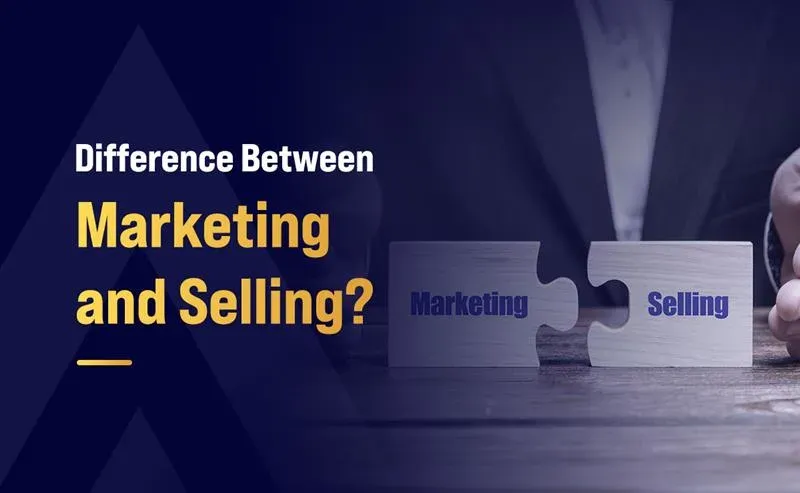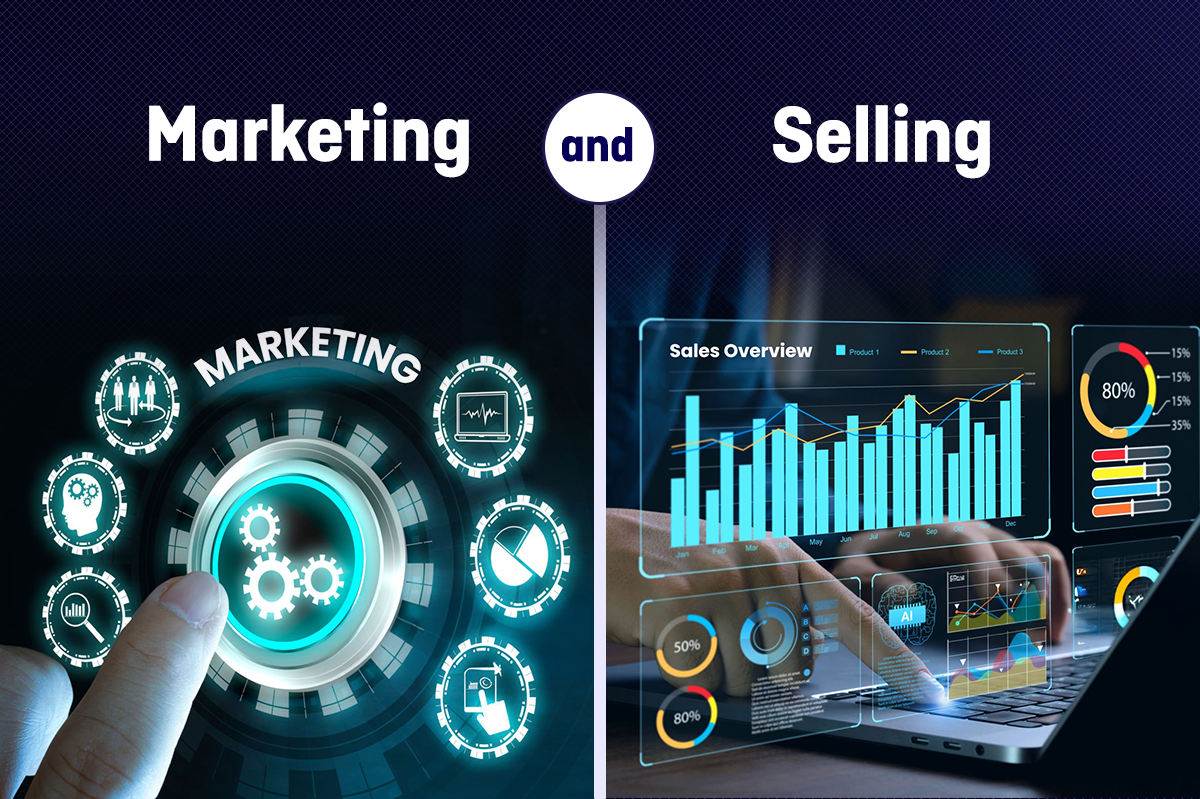Difference Between Marketing and Selling?

In today’s business world, marketing and selling work together but have different roles. Many people think selling and marketing mean the same thing, but they actually serve different purposes.
The main difference is that focus marketing builds brand trust and long-term relationships, while selling is about making immediate sales and convincing customers to buy.
Marketing is about understanding what customers need and creating value for them, while selling is about convincing customers to buy. At Altera Institute, students gain hands-on experience building skills that prepare them for their careers. Our PGP programs can help you learn the basics of marketing and sales.
This article will look at the main differences between selling and marketing, their key features and types, and why bringing them together can help a business grow.
What is Selling?

Selling is the direct process of persuading customers to purchase a product or service. It is the process of exchanging value, in which a buyer perceives value in a product or service and agrees to pay a price for its delivery. It begins with a sales process, triggered by either the buyer or the seller, that involves strategic conversations and commitments.
The primary objective of sales is to transform prospective customers into buyers and earn money. Selling is not merely about products; it is also about selling solutions, developing trust, and producing results. Good sales assistants assist in making informed decisions and satisfying the needs of the customers, which makes the business prosper.

Key Characteristics of Selling
Selling is more than just closing deals. It’s a customer-focused process that aims to build long-term relationships and deliver real value. Modern selling includes these key elements:
- Customer Retention & Segmentation: The Pareto principle states that about 20% of loyal customers account for 80% of a company’s earnings. That’s why today’s sales focus on retaining valuable clients and using resources wisely to boost profits.
- Data-Driven Sales Approach: Sales professionals must leverage customer databases and market intelligence to understand buying patterns, identify opportunities, and enhance sales effectiveness through digital tools and online research.
- Customer Relationship Management (CRM): It is not only about making a one-time transaction, but also about building a long-term partnership in the selling process. An effective sales plan focuses on trust, customer satisfaction, and reciprocal benefits.
- Integration with Marketing: Sales teams now often work closely with marketing, helping with product development, market targeting, and understanding competitors. This teamwork helps attract and keep customers.
- Problem-Solving: Today’s salespeople use critical thinking and give advice, not just make quick sales. Customers want complete solutions, so sales professionals need to meet specific needs with customized offers.
- Value-Driven Selling: Understanding and fulfilling customer needs is at the heart of modern sales. Sales professionals must identify pain points, create demand, and provide solutions that add value beyond the product or service itself.
By focusing on these areas, businesses can improve their sales, build customer loyalty, and stay ahead of the competition.
Examples of Selling
Selling occurs across every industry and business. Some typical examples are as follows:
- Retail Selling: A salesperson in an electronics store assists a customer in buying a smartphone by discussing its features and benefits and finally convinces him or her to purchase it.
- B2B Sales (Business-to-Business): A software company’s sales representative pitches a cloud-based CRM solution to a company’s management team, negotiating terms and closing a contract.
- Cross-Selling and Upselling: When a quick-service restaurant employee suggests complementing a hamburger purchase with potato sides and a beverage, they're boosting the transaction value.
- Tele sales: A representative calls customers to offer them insurance plans.
- Door-to-Door Sales: A salesperson visits homes in a neighborhood, offering energy-efficient home solutions and convincing homeowners to sign up for a service.
Different Types of Selling
Today, businesses use various sales strategies to connect with customers and drive sales.
- Transactional Selling: This is a rapid, volume-oriented model that relies on speed rather than relationships. It occurs in models like eCommerce and retail, where customers like to make their own choices and have little interaction with sales. This is backed by self-service facilities, automated systems, and proper product specifications to minimize friction for businesses.
- Solution Selling: This approach focuses on solving customer problems rather than just talking about product features. Salespeople learn what challenges customers face and demonstrate how their product is the best solution. Success here requires a strong understanding of the customer and the problem, problem-solving skills, and clear communication.
- Consultative Selling: In this approach, salespeople act as trusted advisors and build long-term relationships with clients. They analyze customer needs, leverage data, and provide personalized advice to help buyers find the best solution. This works well for expensive or complex products that need a long-term commitment.
- Provocative Selling: This approach creates urgency by highlighting risks or emerging challenges the buyer hasn’t considered. Sales reps provide industry insights, introduce new perspectives, and provoke action. It works best when targeting decision-makers in uncertain, fast-changing business environments.
- Collaborative Selling: In this team-based approach, buyers and sales teams work together to create custom solutions. It often involves people from different departments and aims for long-term value and customer success. This is common in B2B industries where partnerships are important.
Why is Selling Important?
The primary means through which businesses get money and remain in business is by selling. A firm cannot pay its bills, invest in new ideas, or grow without sales. This is why selling is so valuable to business success:
- Revenue Generation: Sales directly determine a company's top line and provide the financial resources to grow and remain stable. An excellent sales plan will guarantee a continuous flow of revenue to keep the business running.
- Customer Acquisition & Retention: Strategic selling activities bring new business on board and foster the existing customer relationships. Through continuous sales activities, it is possible to build a strong, long-term customer base.
- Competitive Edge: An effective sales plan makes a business stand out from the competition. Proficient sales teams also convey a company's value propositions, making products or services shine in saturated marketplaces.
- Market Insights & Adaptation: Sales teams connect directly with customers and learn about their preferences and new trends. This feedback helps improve marketing, develop better products, and keep the business successful.
In short, selling is more than just making a sale. It’s a key part of growing a business, building customer relationships, and making the company stronger in the market.
What is Marketing?
Marketing is a broad strategy focused on creating, sharing, and delivering value to customers. It includes market research, understanding customers, developing products, setting prices, promoting, and planning how to get products to buyers.
Unlike direct sales, marketing aims for long-term business growth by attracting customers and building loyalty. It lays the groundwork for sales by building awareness and interest before a customer speaks with a salesperson.
Key Characteristics of Marketing
Marketing is an active, strategic process that means understanding what customers want, promoting products or services, and building strong brands. Here are five key traits of good marketing:
- Market Research & Analysis: An effective marketing plan starts with excellent research and analysis. Through this analysis of consumer behavior, consumer trends, and competitive positioning, brands can devise resonant campaigns that appeal to target demographics and differentiate their products from competitors.
- Effective Communication: Marketing depends on clear, strong messages to reach customers. Through ads, online content, or direct contact, marketers need to show the value of their products and build trust and brand awareness.
- Flexibility and Innovation: Marketing is dynamic as customers, technology, and industries continue to change. The companies should remain adaptable, explore new opportunities, and continue refining their strategies.
- Brand Development & Relationship Building: To succeed in the long term, it is important to build a unique brand. The purpose of marketing should be to connect with customers in a genuine way, build loyalty, and ensure the brand's message meets customers' expectations.
- Data-Driven Decision Making: The analysis of the effectiveness of marketing campaigns provides invaluable insights into how to improve the strategy and enhance performance. With the help of analytics, companies can monitor important indicators, assess the success of campaigns, and decide using objective data to increase ROI.
These main traits help make marketing effective, customer-focused, and aligned with business growth goals.
Different Types of Marketing with Examples
There are many types of marketing, each designed for different goals.
1. Content Marketing:
This strategy focuses on teaching and engaging the audience by sharing helpful information in different ways. By giving useful content, businesses attract new customers, build trust, and help people make buying decisions without direct sales.
Examples: Blogs, videos, infographics, e-books, whitepapers.
2. Social Media Marketing:
This uses popular platforms like Facebook, Instagram, and LinkedIn to connect with target audiences. It builds brand recognition and encourages interaction through posts, ads, and content tailored to different customer groups.
Examples: Posts, stories, paid advertisements on Instagram, Facebook, LinkedIn, Twitter.
3. Influencer Marketing:
This type of marketing uses well-known people with trusted reputations to promote products or services. Their recommendations work well because their followers trust them. It’s effective for both consumer and business brands seeking greater exposure and trust.
Examples: Collaborations with industry experts, social media personalities, and thought leaders to establish trust, reach new audiences, and enhance brand credibility.
4. Search Engine Marketing (SEM):
This includes methods such as search engine optimization (SEO) and pay-per-click (PPC) ads to improve a website's visibility in search results. SEO helps with unpaid rankings, while PPC brings quick traffic through paid ads. These methods help companies reach people who are already looking for solutions.
Examples: SEO optimization, PPC advertising, keyword research, and landing page optimization.
5. Email Marketing:
Email marketing enables the company to interact directly with clients by sending newsletters, special offers, and automated messages. It assists in converting leads into customers and maintains good relationships, and is therefore valuable in businesses of any kind.
Examples: Newsletters, promotional offers, automated sequences, personalized recommendations.
Why Is Marketing Important?
A well-planned marketing strategy helps businesses build a strong market position and stay ahead. Here are some key reasons why marketing matters for businesses.
- Enhances Brand Awareness: Marketing helps people recognize and remember a brand, giving businesses a unique identity. When customers see a brand often, they trust it more and are more likely to buy it again.
- Increases Customer Engagement: Effective marketing enables businesses to interact with customers through social media, email, and other content. This engagement builds stronger relationships, increases loyalty, and improves how people see the brand.
- Drives Personalization: Personalized marketing means sending the right messages to the right people, improving customer experience. Custom emails, special offers, and product suggestions help boost engagement and sales.
- Boosts Sales and Revenue: Effective marketing attracts new customers and retains existing ones through targeted campaigns. Special offers, clear messages, and strong branding help increase sales and revenue.
- Provides Valuable Analytics and Insights: Marketing tracks results, customer behavior, and trends. Using this data helps businesses improve their strategies and get better results from their marketing efforts.
Key Difference Between Selling and Marketing

Both marketing and selling are considered "revenue-centric roles" because they directly help a company grow its income. Now, let’s look at the main differences between selling and marketing.
Criteria | Selling | Marketing |
Objective | Primarily concerned with converting prospects into buyers and driving revenue. | Emphasizes creating brand recognition, cultivating market interest, and establishing product demand through coordinated efforts. |
Timeline | It is a short-term approach aimed at immediate sales and achieving revenue targets. | It is a long-term strategy focused on brand-building, customer engagement, and business growth. |
Approach | Product-centric, emphasizing features and benefits to persuade buyers. | Customer-centric, understanding consumer needs and behaviors to craft compelling messages. |
Scope | Narrower scope, involving direct communication methods like calls, meetings, and negotiations. | Broader scope, covering advertising, branding, content marketing, social media, SEO, and market research. |
Customer Interaction | Direct one-on-one interactions through calls, meetings, and negotiations. | Indirect communication via advertisements, social media, emails, and digital content. |
Target Audience | Narrower focus on the most relevant individuals or groups showcasing an intent to buy. | Broader reach to create interest and nurture potential buyers over time. |
Messaging Style | Personalized messages tailored to specific customer objections and needs. | Storytelling and value-driven communication aimed at a wider audience. |
Performance Indicators | Success is measured by deals closed, conversion rates, and revenue generated. | Metrics include brand awareness, website traffic, engagement, and lead generation. |
Adaptability | Adapts to individual customer needs, addressing specific concerns and objections. | Transforms continually in response to shifting market conditions, evolving consumer preferences, and emerging technological capabilities. |
Customer Relationships | More transactional, focusing on fulfilling immediate needs. | Builds long-term relationships through consistent engagement and trust-building. |
Why You Should Align Sales and Marketing?
In today’s highly competitive market, it’s important to align sales and marketing to reach business goals. Both are "revenue-centric roles" because they directly help a company grow its income.
This sets them apart from "cost-centric" roles like HR, operations, or accounting, which support the business but don’t generate revenue. Revenue-focused roles often offer more career growth, and combining sales and marketing helps create a smooth customer experience from first contact to purchase.
When sales and marketing collaborate, they settle on the types of people who make up the ideal customers. Then marketing can get the right people, and sales can make them buyers. This collaboration ensures that messages are consistent across all channels and builds trust regardless of how customers discover the brand.
Moreover, information exchange among departments is an invaluable resource that helps refine targeting, increase conversion rates, and improve resource allocation. As a result, studies show that organizations with well-integrated sales and marketing departments tend to achieve 36% higher customer retention rates and 38% higher sales success rates than companies with siloed operations.
FAQ
Q1. What distinguishes marketing from sales marketing as a business function?
Ans: Marketing involves overarching strategic efforts to create brand presence, drive the market, and develop customer relationships with the help of various media, such as advertising, the creation of content, and the use of social platforms. It supports the establishment of long-term customer relations and business expansion.
Sales marketing, on the other hand, is more focused and more targeted, linking marketing to the sales process. It is concerned with lead generation, prospect management, and sales through promotions, direct outreach, and conversion-oriented campaigns. As marketing creates interest, sales marketing sees that the interest is indeed converted into real earnings.
Q2. How is marketing different from a market within the business environment?
Ans: The concept of marketing is the planned, purposeful effort by companies to promote their products and services, create brand awareness and customer relationships, such as promotional tactics, original content creation, working on social media, setting a value strategy, and managing the channel.
A market, conversely, constitutes the commercial ecosystem where trade transactions occur, comprising prospective buyers, industry rivals, and the surrounding economic factors that shape business exchanges and consumer behavior.
Markets can be defined by geography, demographics, or specific product categories. Simply put, marketing is what businesses do to connect with customers, while a market is where these connections happen.
Summing Up
Selling and marketing are closely linked, but they have different roles in business. Marketing creates demand, builds brand awareness, and builds long-term customer relationships. Selling is about turning potential customers into buyers.
When marketing and sales work together, customers have a smoother experience, more people become buyers, and brand loyalty grows. Businesses that combine these strategies well get ahead of the competition, grow their revenue, and build strong customer relationships.





